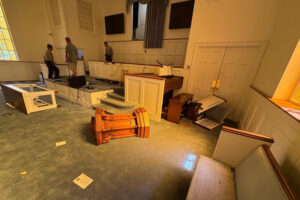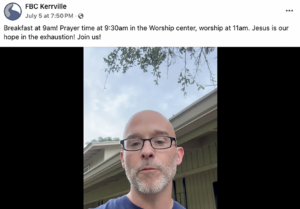
EVANSTON, Ill. (BP)–In a week when I read about author Hunter Thompson’s ashes being shot out of a cannon in Colorado, when my classical philosophy class at Southern Seminary read through Plato’s Phaedo (where Socrates shows the greatest disrespect for the body), and when, preaching through Genesis, I came to chapter 50, which concerns the remains of Jacob and Joseph, I couldn’t help but think of cremation.
Nationwide, one-fourth of the dead are cremated, and that percentage is much higher in some states, such as Colorado, where it is 50 percent. What is one to think when a loved one says they prefer it?
The arguments given for cremation include the following: 1. It’s less expensive, roughly one-fifth the cost of the traditional funeral; 2. It takes up less space; 3. The remains and their fortunes aren’t as “yucky.” Furthermore, the Bible doesn’t prohibit it, and it won’t be a hindrance to resurrection. God can reconstitute your body wherever, whenever and however He pleases.
Still, I lean toward a traditional burial. Let me offer 10 reasons:
— It shows peculiar reverence for the body. In the first century, many thought the body was vile, but Jesus became incarnate, to the consternation of Gnostics and their fellow travelers. In our century, the culture adores the body, spending billions for fitness club memberships, flattering fashions, cosmetic surgery, manicures and such. But there is little appreciation for bodies “past their prime,” for bodies broken by disease or accident. But loved ones cannot help but cherish the last touch of a wrinkled hand, with liver spots and veins ruptured by multiple IV punctures. Here was a body which bore you in its womb, which nursed you, which held you it its arms when you were struck with fever. It was a body whose face, limbs and stature were a comfort to you, not as so much “sand,” but as a creature in human form. And it is in that form that they are buried. Furthermore, economy and efficiency are the bottom line in garbage disposal, not in the disposition of human remains.
— It teaches resurrection of the dead. The Greeks and Romans were prone to burn their dead, but the Christians believed that their departed were only sleeping — hence, the word “cemetery” from the Greek verb, komein, “to sleep.” (By the way, the Latin version is “dormitory,” from which the dead arise for class.)
— It speaks the language of creeds and hymnody. From the “was buried, and rose again on the third day” of Nicea to the “He arose!” of “Low in the Grave He Lay” to the “Dem bones gonna walk around” of the spiritual “Dry Bones,” Christian worship is full of reference to the burial and resurrection of recognizable bodies. On Easter, we don’t sing, “Fast, on the winds he blew…. ” or “Sprinkled about he was….”
— It sustains the imagery of baptism. Romans 6:4 reads, “We were therefore buried with him through baptism into death in order that, just as Christ was raised from the dead through the glory of the Father, we too may life a new life.” I’d hate to think what sort of ceremony cremation would suggest.
— It shuns bad associations. I suppose I could preach wearing shades and a sequined jump suit with cape, but my congregation would have trouble getting past the Elvis of it all. Through the centuries, the Christian church has associated the burning of the dead with paganism, whether in the Valley of Hinnom (cf. “gehenna”) or on the Hindu pyre. Of course, a Christian consumed in a fiery car accident is no less spiritually secure than one who dies intact, but for many, it seems odd to intentionally burn those who died, unless it was a dire matter of disease prevention.
— It enjoys good associations. From Genesis 50 to Lazarus to Gethsemane, from Augustine, to Luther, to Annie Armstrong, burial of an intact body has been the norm in Christian circles.
— It seems to best satisfy the human psyche. The military’s painstaking retrieval of bodies, whether under the fire of combat or in the archaeologist-like search for bones at decades-old airplane crash sites, reflects this concern for more than tokens of the departed. Interest in wakes, visitations, vaults, embalming, and ossuaries seems to be a natural outworking of a fundamental human interest macro-preservation. Perhaps it is a sad attempt to deny the reality of death, but it is just as likely a function of reverence for these “jars of clay.”
— It tweaks the environmental extremists. Much environmentalist literature disparages “anthropomorphism,” the elevation of mankind above the rest of nature. People for the Ethical Treatment of Animals (PETA) calls Thanksgiving “Holocaust on a Plate,” comparing the slaughter of turkeys to the slaughter of Jews in Auschwitz. Zero Population Growth (ZPG) fanatics try to intimidate those who would presume to “clutter” and “choke” the world with more than two kids. For one thing, all 6.5 billion people in the world could stand together within the city limits of Houston, Texas. We’ve got room for more people. But, of course, you need more space for burial. Still, it’s not that daunting. Providing a generous nine-foot by six-foot plot for each person, all of Illinois’ 12.5 million residents could be buried in about 25 square miles, or about a square quarter mile in each of the state’s 102 counties. We can manage, thank-you.
— It magnifies cemeteries. Not only do cemeteries testify to man’s mortality — a useful message in a world disinclined to contemplate such sobering truth — but they also serve as a rich cultural and spiritual resource. If scattered ashes, mantle urns, or tiny plots were the norm, then one would miss such stirring experiences as a visit to the graves of Southern Baptist greats in Louisville’s Cave Hill Cemetery –- John Broadus, J. M. Frost, and A. T. Robertson.
— It can serve archaeology and forensics. Scientists and historians are indebted to those who have chosen traditional burial.
Please don’t think this is an ad for funeral directors and cemetery developers. While many are honorable and helpful, others are predatory, exploiting the vulnerability of grieving families. The explosion of interest in cremation and do-it-yourself burials is in large measure a reaction to the funeral industry’s cost racketeers. But the issues are separable, and the point stands: The traditional burial has much to recommend it.
–30–
Mark Coppenger is pastor of Evanston (Ill.) Baptist Church and distinguished professor of apologetics at Southern Baptist Theological Seminary in Louisville, Ky. Reprinted from the Illinois Baptist newsjournal, online at www.ibsa.org/illinoisbaptist.














